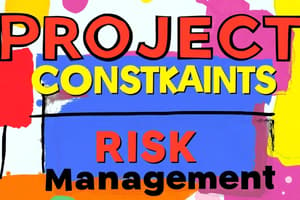Podcast
Questions and Answers
A high-profile stakeholder has disengaged from the project, no longer attending key meetings or responding to status updates. Other stakeholders still recognize their influence, and there is concern their lack of participation may delay approvals. What should the project manager do?
A high-profile stakeholder has disengaged from the project, no longer attending key meetings or responding to status updates. Other stakeholders still recognize their influence, and there is concern their lack of participation may delay approvals. What should the project manager do?
- Continue project work as planned, assuming their absence is a sign of trust.
- Engage the stakeholder directly to understand their concerns and reinforce their role. (correct)
- Assign another stakeholder to represent their interests without further discussion.
- Escalate the issue to leadership and request formal re-engagement.
A local government agency unexpectedly introduces new compliance requirements that significantly impact the project scope. Some stakeholders believe these regulations should be challenged, while others insist on immediate adaptation. What should the project manager do?
A local government agency unexpectedly introduces new compliance requirements that significantly impact the project scope. Some stakeholders believe these regulations should be challenged, while others insist on immediate adaptation. What should the project manager do?
- Challenge the regulations formally before making any project adjustments.
- Assess the impact of compliance changes while negotiating feasible implementation strategies. (correct)
- Proceed with existing plans and adjust later if enforcement becomes strict.
- Assign legal counsel to manage compliance while the team focuses on execution.
A key investor is becoming impatient with the project timeline, demanding faster progress despite known constraints. The investor has no direct authority over project execution but holds significant financial influence. What should the project manager do?
A key investor is becoming impatient with the project timeline, demanding faster progress despite known constraints. The investor has no direct authority over project execution but holds significant financial influence. What should the project manager do?
- Ignore the investor's concerns since they lack direct authority.
- Manage expectations through transparent reporting and phased progress updates. (correct)
- Escalate the issue to leadership and request a strategic decision.
- Prioritize speed over other constraints to maintain investor confidence.
A senior executive is actively bypassing formal stakeholder communication channels, giving direct instructions to team members. This is causing confusion and misalignment with project priorities. What should the project manager do?
A senior executive is actively bypassing formal stakeholder communication channels, giving direct instructions to team members. This is causing confusion and misalignment with project priorities. What should the project manager do?
A community advocacy group has begun publicly opposing a project initiative, claiming it will negatively impact local stakeholders. The organization was not initially identified as a key stakeholder, but their influence is now growing. What should the project manager do?
A community advocacy group has begun publicly opposing a project initiative, claiming it will negatively impact local stakeholders. The organization was not initially identified as a key stakeholder, but their influence is now growing. What should the project manager do?
A regulatory body has flagged a potential compliance risk in the project but has not provided clear directives on how to proceed. Some stakeholders suggest waiting for formal guidelines, while others believe the team should proactively implement solutions.What should the project manager do?
A regulatory body has flagged a potential compliance risk in the project but has not provided clear directives on how to proceed. Some stakeholders suggest waiting for formal guidelines, while others believe the team should proactively implement solutions.What should the project manager do?
A customer stakeholder group has started demanding weekly reporting updates that were not part of the original communication plan. The team is concerned about the additional workload, while stakeholders insist on greater transparency. What should the project manager do?
A customer stakeholder group has started demanding weekly reporting updates that were not part of the original communication plan. The team is concerned about the additional workload, while stakeholders insist on greater transparency. What should the project manager do?
A project sponsor has started micromanaging execution, directly instructing team members on technical details. Some stakeholders believe this undermines the project manager's authority, while the sponsor insists their involvement ensures success. What should the project manager do?
A project sponsor has started micromanaging execution, directly instructing team members on technical details. Some stakeholders believe this undermines the project manager's authority, while the sponsor insists their involvement ensures success. What should the project manager do?
A vendor stakeholder is proposing scope changes that would increase their contract value but are not aligned with project priorities. Some stakeholders see potential benefits, while others believe the changes are unnecessary and costly. What should the project manager do?
A vendor stakeholder is proposing scope changes that would increase their contract value but are not aligned with project priorities. Some stakeholders see potential benefits, while others believe the changes are unnecessary and costly. What should the project manager do?
A diverse stakeholder group has conflicting expectations about how project benefits should be measured. Some prioritize financial impact, while others emphasize social and environmental outcomes. What should the project manager do?
A diverse stakeholder group has conflicting expectations about how project benefits should be measured. Some prioritize financial impact, while others emphasize social and environmental outcomes. What should the project manager do?
A government agency unexpectedly updates its permitting requirements, requiring additional documentation. The agency has not provided a clear deadline for compliance, but some stakeholders want to proceed without delay, while others prefer to pause until requirements are confirmed. What should the project manager do?
A government agency unexpectedly updates its permitting requirements, requiring additional documentation. The agency has not provided a clear deadline for compliance, but some stakeholders want to proceed without delay, while others prefer to pause until requirements are confirmed. What should the project manager do?
A project team is receiving conflicting input from multiple executive stakeholders, each with competing priorities. Some executives want the project to focus on speed, while others emphasize cost control. The misalignment is delaying execution. What should the project manager do?
A project team is receiving conflicting input from multiple executive stakeholders, each with competing priorities. Some executives want the project to focus on speed, while others emphasize cost control. The misalignment is delaying execution. What should the project manager do?
A customer advisory board is lobbying for a feature enhancement, arguing it would increase long-term product value. However, the enhancement conflicts with the project's existing timeline and budget constraints. What should the project manager do?
A customer advisory board is lobbying for a feature enhancement, arguing it would increase long-term product value. However, the enhancement conflicts with the project's existing timeline and budget constraints. What should the project manager do?
A project sponsor is pushing for increased stakeholder visibility, requiring all project updates to be shared publicly. Some team members are concerned that sensitive information may be misinterpreted, while others welcome the transparency. What should the project manager do?
A project sponsor is pushing for increased stakeholder visibility, requiring all project updates to be shared publicly. Some team members are concerned that sensitive information may be misinterpreted, while others welcome the transparency. What should the project manager do?
A regulatory body has imposed an unexpected audit on the project, requiring substantial documentation that was not initially planned. Some stakeholders are concerned about compliance risks, while others see this as an unnecessary distraction. What should the project manager do?
A regulatory body has imposed an unexpected audit on the project, requiring substantial documentation that was not initially planned. Some stakeholders are concerned about compliance risks, while others see this as an unnecessary distraction. What should the project manager do?
A regional project partner is negotiating for more influence over decisions, arguing that their local expertise is being undervalued. Other stakeholders fear that shifting control could impact the project's global consistency. What should the project manager do?
A regional project partner is negotiating for more influence over decisions, arguing that their local expertise is being undervalued. Other stakeholders fear that shifting control could impact the project's global consistency. What should the project manager do?
A supplier has requested an extension on their contract obligations, citing unforeseen disruptions. Some stakeholders are willing to adjust, while others insist the supplier must meet the original terms. What should the project manager do?
A supplier has requested an extension on their contract obligations, citing unforeseen disruptions. Some stakeholders are willing to adjust, while others insist the supplier must meet the original terms. What should the project manager do?
An internal stakeholder is opposing the project due to misalignment with their department's strategic goals. Despite multiple discussions, they remain resistant and are influencing others to share their concerns. What should the project manager do?
An internal stakeholder is opposing the project due to misalignment with their department's strategic goals. Despite multiple discussions, they remain resistant and are influencing others to share their concerns. What should the project manager do?
A customer advocacy group has raised concerns about the ethical implications of a project, requesting a third-party review. Some stakeholders believe the request will cause delays, while others argue that it builds credibility. What should the project manager do?
A customer advocacy group has raised concerns about the ethical implications of a project, requesting a third-party review. Some stakeholders believe the request will cause delays, while others argue that it builds credibility. What should the project manager do?
A highly engaged stakeholder is dominating meetings, making it difficult for other perspectives to be heard. While their input is valuable, other team members feel excluded from discussions. What should the project manager do?
A highly engaged stakeholder is dominating meetings, making it difficult for other perspectives to be heard. While their input is valuable, other team members feel excluded from discussions. What should the project manager do?
A project has shifted its strategic focus, and some stakeholders who were previously supportive are now questioning its long-term viability. Leadership is expecting full alignment, but resistance is growing among key decision-makers. What should the project manager do?
A project has shifted its strategic focus, and some stakeholders who were previously supportive are now questioning its long-term viability. Leadership is expecting full alignment, but resistance is growing among key decision-makers. What should the project manager do?
A key supplier is struggling to meet their commitments, and some stakeholders are pushing for contract termination to mitigate risks. Others believe that continued engagement is necessary to avoid further disruptions. What should the project manager do?
A key supplier is struggling to meet their commitments, and some stakeholders are pushing for contract termination to mitigate risks. Others believe that continued engagement is necessary to avoid further disruptions. What should the project manager do?
A senior executive has announced a major organizational restructuring, which may impact project funding. Some stakeholders are worried about resource availability, while others are uncertain about long-term priorities. What should the project manager do?
A senior executive has announced a major organizational restructuring, which may impact project funding. Some stakeholders are worried about resource availability, while others are uncertain about long-term priorities. What should the project manager do?
A community group has filed a formal complaint about the project, arguing that it disregards local interests. Leadership wants to avoid delays, but some stakeholders believe public engagement is necessary. What should the project manager do?
A community group has filed a formal complaint about the project, arguing that it disregards local interests. Leadership wants to avoid delays, but some stakeholders believe public engagement is necessary. What should the project manager do?
A newly appointed project sponsor has a different leadership style than their predecessor and is requesting more direct involvement in decision-making. Some stakeholders welcome the change, while others are concerned about micromanagement. What should the project manager do?
A newly appointed project sponsor has a different leadership style than their predecessor and is requesting more direct involvement in decision-making. Some stakeholders welcome the change, while others are concerned about micromanagement. What should the project manager do?
A highly influential external stakeholder has requested an exclusive briefing on project progress, separate from the standard reporting process. Some team members view this as favoritism, while others see it as a necessary political move. What should the project manager do?
A highly influential external stakeholder has requested an exclusive briefing on project progress, separate from the standard reporting process. Some team members view this as favoritism, while others see it as a necessary political move. What should the project manager do?
A project milestone has been missed, and some stakeholders are blaming insufficient risk management, while others cite external market factors. Leadership wants a clear explanation before determining next steps. What should the project manager do?
A project milestone has been missed, and some stakeholders are blaming insufficient risk management, while others cite external market factors. Leadership wants a clear explanation before determining next steps. What should the project manager do?
A diverse stakeholder group is struggling to reach consensus on a key project decision. Some favor an aggressive expansion strategy, while others prefer a more conservative approach. Deadlocks are delaying execution. What should the project manager do?
A diverse stakeholder group is struggling to reach consensus on a key project decision. Some favor an aggressive expansion strategy, while others prefer a more conservative approach. Deadlocks are delaying execution. What should the project manager do?
A regulatory agency is conducting an unexpected audit, raising concerns about compliance gaps. Some stakeholders want to pause project work, while others believe continued execution is necessary to meet commitments. What should the project manager do?
A regulatory agency is conducting an unexpected audit, raising concerns about compliance gaps. Some stakeholders want to pause project work, while others believe continued execution is necessary to meet commitments. What should the project manager do?
A project team member has privately expressed concerns about unethical behavior by a senior stakeholder. The accusation lacks concrete evidence, but the issue is potentially serious. What should the project manager do?
A project team member has privately expressed concerns about unethical behavior by a senior stakeholder. The accusation lacks concrete evidence, but the issue is potentially serious. What should the project manager do?
Flashcards
Disengaged Stakeholder
Disengaged Stakeholder
Engage directly to understand concerns and reinforce their role.
New Compliance Requirements
New Compliance Requirements
Assess impact while negotiating feasible implementation strategies.
Impatient Investor
Impatient Investor
Manage expectations through transparent reporting and phased progress updates.
Executive Bypassing Channels
Executive Bypassing Channels
Signup and view all the flashcards
Opposing Advocacy Group
Opposing Advocacy Group
Signup and view all the flashcards
Potential Compliance Risk
Potential Compliance Risk
Signup and view all the flashcards
Demanding Weekly Updates
Demanding Weekly Updates
Signup and view all the flashcards
Sponsor Micromanaging
Sponsor Micromanaging
Signup and view all the flashcards
Vendor Scope Changes
Vendor Scope Changes
Signup and view all the flashcards
Conflicting Benefit Expectations
Conflicting Benefit Expectations
Signup and view all the flashcards
Updated Permitting Requirements
Updated Permitting Requirements
Signup and view all the flashcards
Conflicting Executive Priorities
Conflicting Executive Priorities
Signup and view all the flashcards
Lobbying for Feature Enhancement
Lobbying for Feature Enhancement
Signup and view all the flashcards
Visibility Increase Request
Visibility Increase Request
Signup and view all the flashcards
Unexpected Audit
Unexpected Audit
Signup and view all the flashcards
Negotiating Influence
Negotiating Influence
Signup and view all the flashcards
Extension Request
Extension Request
Signup and view all the flashcards
Opposing Internal Stakeholder
Opposing Internal Stakeholder
Signup and view all the flashcards
Third Party Review Ethical
Third Party Review Ethical
Signup and view all the flashcards
Stakeholder Dominating
Stakeholder Dominating
Signup and view all the flashcards
Has Shifted Focus
Has Shifted Focus
Signup and view all the flashcards
Struggling meet Commitments
Struggling meet Commitments
Signup and view all the flashcards
Major Organizational Restructuring
Major Organizational Restructuring
Signup and view all the flashcards
Filed Formal Disregards
Filed Formal Disregards
Signup and view all the flashcards
Appointed Style
Appointed Style
Signup and view all the flashcards
Briefing Process
Briefing Process
Signup and view all the flashcards
Milestone Risk Strategy
Milestone Risk Strategy
Signup and view all the flashcards
Aggressive Staking Deadlocks
Aggressive Staking Deadlocks
Signup and view all the flashcards
Conduction Audit
Conduction Audit
Signup and view all the flashcards
Privately Concerns Behavior
Privately Concerns Behavior
Signup and view all the flashcards
Study Notes
- A high-profile stakeholder has disengaged from the project due to concerns their lack of participation may delay approvals, so the project manager should directly engage them to understand their concerns and reinforce their role.
- New compliance requirements that significantly impact the project scope are introduced by a local government agency, so the project manager should assess the impact of compliance changes while negotiating feasible implementation strategies.
- A key investor is becoming impatient with the project timeline, so the project manager should manage expectations through transparent reporting and phased progress updates.
- A senior executive is bypassing formal stakeholder communication channels, so the project manager should clarify governance processes while engaging the executive to reinforce structured communication.
- A community advocacy group, now a key stakeholder, is publicly opposing a project initiative, so the project manager should engage the advocacy group to understand their concerns and identify mitigation options.
- A regulatory body has flagged a potential compliance risk in the project but has not provided clear directives on how to proceed, so the project manager should evaluate potential compliance risks and implement precautionary measures.
- A customer stakeholder group has started demanding weekly reporting updates the project manager should negotiate a reporting format that balances transparency and efficiency.
- A project sponsor has started micromanaging execution, so the project manager should reinforce governance roles while ensuring the sponsor feels involved in key decisions.
- A vendor stakeholder is proposing scope changes that would increase their contract value but are not aligned with project priorities, so the project manager should assess the proposal's impact while ensuring alignment with project objectives.
- A diverse stakeholder group has conflicting expectations about how project benefits should be measured, so the project manager should facilitate alignment by defining multi-criteria success metrics that address different priorities.
- A government agency unexpectedly updates its permitting requirements, requiring additional documentation, the project manager should engage the agency to clarify expectations while ensuring project risks are mitigated.
- A project team is receiving conflicting input from multiple executive stakeholders, so the project manager should facilitate stakeholder alignment by defining shared priorities and trade-offs.
- A customer advisory board is lobbying for a feature enhancement, so the project manager should assess feasibility and negotiate trade-offs while keeping stakeholders engaged.
- A project sponsor is pushing for increased stakeholder visibility, so the project manager should define a communication strategy that balances transparency with risk management.
- A regulatory body has imposed an unexpected audit on the project, so the project manager coordinate a response that ensures compliance while minimizing project disruption.
- A regional project partner is negotiating for more influence over decisions, so the project manager should facilitate discussions that balance regional expertise with global project alignment.
- A supplier has requested an extension on their contract obligations, citing unforeseen disruptions, so the project manager should negotiate a revised agreement that considers feasibility while managing risk.
- An internal stakeholder is opposing the project due to misalignment with their department's strategic goals, so the project manager should engage the stakeholder to explore shared benefits while addressing their concerns.
- A customer advocacy group has raised concerns about the ethical implications of a project, requesting a third-party review, so the project manager should evaluate the impact of the request while maintaining project progress.
- A highly engaged stakeholder is dominating meetings, so the project manager should implement structured facilitation techniques to ensure all voices are heard.
- A project has shifted its strategic focus, and some stakeholders were now questioning its long-term viability, so the project manager should engage stakeholders to address concerns while reinforcing the strategic benefits.
- A key supplier is struggling to meet their commitments, so the project manager should negotiate a recovery plan while assessing long-term supplier reliability.
- A senior executive has announced a major organizational restructuring, so the project manager should clarify project alignment with organizational goals while addressing stakeholder concerns.
- A community group has filed a formal complaint about the project, so the project manager should engage the community to explore concerns while maintaining project commitments.
- The newly appointed project sponsor has a different leadership style, so the project manager should clarify the sponsor's role while ensuring stakeholder alignment on governance.
- A highly influential external stakeholder has requested an exclusive briefing on project progress, so the project manager should ensure stakeholder engagement is equitable while addressing unique concerns.
- A project milestone has been missed, so the project manager should conduct a root cause analysis while ensuring stakeholders remain aligned on risk strategy.
- A diverse stakeholder group is struggling to reach consensus on a key project decision, so the project manager should facilitate a structured decision-making process that ensures balanced stakeholder input.
- A regulatory agency is conducting an unexpected audit, so the project manager should ensure audit readiness while minimizing project disruption.
- A project team member has privately expressed concerns about unethical behavior by a senior stakeholder, so the project manager should follow organizational ethics procedures while protecting confidentiality.
Studying That Suits You
Use AI to generate personalized quizzes and flashcards to suit your learning preferences.




